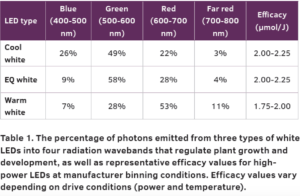White LEDs for Plant Applications
Light-emitting diodes (LEDs) are increasingly being used for plant applications to supplement sunlight in greenhouses and to provide the only source of light indoors. As mentioned in the September 2018 issue of GPN, many horticultural fixtures combine blue and red LEDs. However, there are merits to using fixtures that partly or completely contain white LEDs.

Practically all white LEDs are blue LEDs that are coated with phosphors. The phosphors absorb the blue light and re-emit some or most of the photons into green and red light. A tremendous amount of research has been, and continues to be, focused on the design and development of LED phosphors.
Some of the research objectives include 1) higher conversion efficacy, so less energy is lost in the photon conversion process, 2) fine tuning the properties of light to create a more “desirable” spectrum, 3) use of abundant and inexpensive elements to reduce cost, and 4) phosphor placement considering location, shape, thickness and thermal management of the LED.
The composition of the phosphor coating on a blue LED determines the spectral quality of the white light emitted. Common elements used in the phosphors include calcium, barium, and strontium. Figure 1 provides the relative spectral distribution of three types of white LEDs. They show the characteristic peak of blue light around 430 to 450 nm, but the magnitude of that peak varies considerably. A cool-white LED emits a lot of blue light (peak = 432 nm) and thus, appears slightly blueish white to us. Equalized (EQ) white emits a lot of green light (peak = 556 nm) and has a mint-white appearance. A warm-white LED emits a lot of red light (peak = 637 nm) and appears slightly pinkish white.
 For plant applications, we focus on the traditional waveband of photosynthetic radiation, which includes blue light (400 to 500 nm), green light (500 to 600 nm) and red light (600 to 700 nm) (Table 1). However, we are learning the important roles that far-red radiation (700 to 800 nm) plays on plant growth, especially on the promotion of leaf expansion and stem extension. In addition, the inclusion of far red in a radiation spectrum can accelerate flowering of some crops, particularly long-day plants.
For plant applications, we focus on the traditional waveband of photosynthetic radiation, which includes blue light (400 to 500 nm), green light (500 to 600 nm) and red light (600 to 700 nm) (Table 1). However, we are learning the important roles that far-red radiation (700 to 800 nm) plays on plant growth, especially on the promotion of leaf expansion and stem extension. In addition, the inclusion of far red in a radiation spectrum can accelerate flowering of some crops, particularly long-day plants.
When considering the waveband from 400 to 800 nm, about 3 percent of the photons from cool-white LEDs are in the far-red region, whereas for warm-white LEDs, 11 percent are in the far red waveband. In comparison, a typical blue+red LED spectrum emits at most 1 percent far-red radiation. These nuances are much more relevant when growing crops indoors (with sole-source lighting) compared with greenhouse (supplemental) lighting.
Until a few years ago, I didn’t consider the color-rendering index (CRI) of a light source to be relevant in horticultural lighting. The CRI refers to how well a light source reveals the colors of objects compared with sunlight. White LEDs have fairly high CRI values (> 60 on a scale up to 100), whereas red+blue LED fixtures have negative values. Plants can grow well under lamps with a low CRI, but some people have challenges working in an environment with a low CRI. Fixtures that contain at least some white LEDs can increase the CRI value dramatically, creating a more pleasant working environment.
The only downside of white LEDs is that they are slightly less efficient than blue LEDs and moderately less efficient than red LEDs. Potential advantages of white LEDs are that the CRI value is increased, creating a more pleasant environment for people, and the emission of far-red radiation can elicit desirable plant growth responses.


 Video Library
Video Library 




















